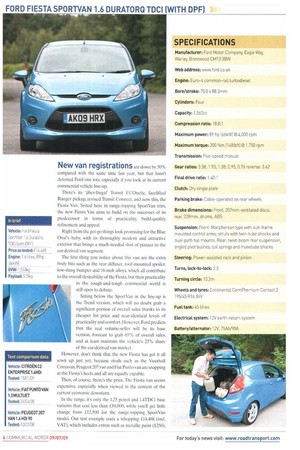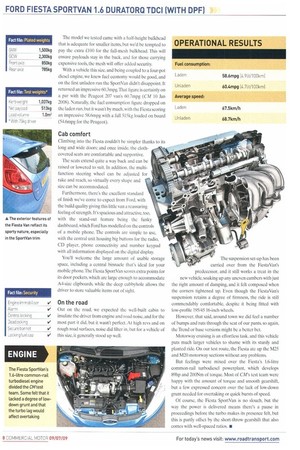New van registrations are down by 50% compared with the
Page 36

Page 37

Page 38

If you've noticed an error in this article please click here to report it so we can fix it.
same time last year, hut that hasn't deterred Ford one iota, especially if you look at its current commercial vehicle line-up.
There's its 'fiber-frugal' Transit ECOnetic, facelifted Ranger pickup, revised Transit Connect, and now this, the Fiesta Van. Tested here in range-topping SportVan trim, the new Fiesta Van aims to build on the successes of its predecessor in terms of practicality, build-quality, refinement and appeal.
Right from the get-go things look promising for the Blue Oval's baby, with its thoroughly modern and attractive exterior that brings a much-needed shot of pizzazz to the car-derived van segment.
The first thing you notice about this van are the extra body bits such as the rear diffuser, roof-mounted spoiler, low-slung bumper and 16-inch alloys, which all contribute to the overall desirability of the Fiesta, but their practicality in the rough-and-tough commercial world is still open to debate.
Sitting below the SportVan in the line-up is the Trend version, which will no doubt grab a significant portion of overall sales thanks to its cheaper list price and near-identical levels of practicality and comfort. However, Ford predicts that the real volume-seller will be its base version, forecast to grab 65% of overall sales, and at least maintain the vehicle's 25% share of the car-derived van market.
However, don't think that the new Fiesta has got it all sewn up just yet, because rivals such as the Vauxhall Corsavan, Peugeot 207 van and Fiat Punt° van arc snapping at the Fiesta's heels and all are equally capable.
Then, of course, there's the price. The Fiesta van seems expensive, especially when viewed in the context of the current economic downturn.
In the range, it's only the 1.25 petrol and 1.4TDCi base variants that cost less than £10,000, while you'll get little change from £12,500 for the range-topping SportVan model. Our test example costs a whopping £14,468 (incl. VAT), which includes extras such as metallic paint (i250).
automatic climate control (550) and a perimeter alarm (f150), but it did still feel a little Spartan thanks to the absence of metallic foot pedals (.22) and illuminated front scuff plates (€130).
Productivity It's easy to get sidetracked by the distinctive looks and luxury features of the SportVan and forget about its mission: ferrying goods of a commercial nature.
Perhaps most surprising, load volume remains the same as the predecessor at 1.0m3, and at this end of the market, you won't really need a great deal more.
Potential customers will be more concerned with payload allowance, however, which, in this case, has dropped by 28kg to 51.5kg. Compare that with the Corsavan's 5504 and you start to wonder if the Fiesta is the LCV's equivalent of tennis beauty Anna Kournikova — all show and not enough professional 'go'.
That said, however, we doubt if any operators will load small vans like these to the bumpstops anyway. The model we tested came with a half-height bulkhead that is adequate for smaller items, but we'd be tempted to pay the extra £100 for the full-mesh bulkhead. This will ensure payloads stay in the back, and for those carrying expensive tools, the mesh will offer added security With a vehicle this size, and being coupled to a four-pot diesel engine, we knew fuel economy would be good, and on the first unladen run the SportVan didn't disappoint. It returned an impressive 60.3mpg.That figure is certainly on a par with the Peugeot 207 van's 60.7mpg (CM 10 Jan 2008). Naturally, the fuel consumption figure dropped on the laden run, but it wasn't by much, with the Fiesta scoring an impressive 58.6mpg with a full 515kg loaded on board (54.6mpg for the Peugeot).
Cab comfort
Climbing into the Fiesta couldn't he simpler thanks to its long and wide doors; and once inside, the clothcovered seats are comfortable and supportive.
The seats extend quite a way back and can be raised or lowered to suit. In addition, the multifunction steering wheel can be adjusted for rake and reach, so virtually every shape and size can be accommodated.
Furthermore, there's the excellent standard of finish we've come to expect from Ford, with the build quality giving this little van a reassuring feeling of strength. It's spacious and attractive, too, with the stand-out feature being the funky dashboard, which Ford has modelled on the controls of a mobile phone. The controls are simple to use, with the central unit housing big buttons for the radio, CD player, phone connectivity and number keypad with all information displayed on the digital display.
You'll welcome the large amount of usable storage space, including a central binnacle that's ideal for your mobile phone. The Fiesta SportVan scores extra points for its door pockets, which are large enough to accommodate A4-size clipboards, while the deep cubbyhole allows the driver to store valuable items out of sight.
On the road
Out on the road, we expected the well-built cabin to insulate the driver from engine and road noise, and for the most part it did, but it wasn't perfect. At high revs and on rough road surfaces, noise did filter in, but for a vehicle of this size, it generally stood up well. The suspension set-up has been carried over from the FiestaVan's predecessor, and it still works a treat in the new vehicle, soaking up any uneven cambers with just the right amount of damping, and it felt composed when the corners tightened up. Even though the FiestaVan's suspension retains a degree of firmness, the ride is still commendably comfortable, despite it being fitted with low-profile 195/45 16-inch wheels.
However, that said, around town we did feel a number of bumps and ruts through the seat of our pants, so again, the Trend or base versions might be a better bet.
Motorway cruising is an effortless task, and this vehicle puts much larger vehicles to shame with its sturdy and planted ride. On our test route, the Fiesta ate up the M25 and M20 motorway sections without any problems.
But feelings were mixed over the Fiesta's 1.6-litre common-rail turbodiesel powerplant, which develops 89hp and 200Nm of torque. Most of CM's lest team were happy with the amount of torque and smooth gearshift, but a few expressed concern over the lack of low-down grunt needed for overtaking or quick bursts of speed.
Of course, the Fiesta SportVan is no slouch, but the way the power is delivered means there's a pause in proceedings before the turbo makes its presence felt, but this is partly offset by the short-throw gearshift that also comes with well-spaced ratios. •












































































































































